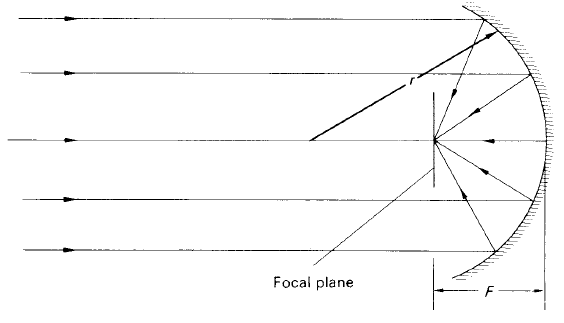


 الفيزياء الكلاسيكية
الفيزياء الكلاسيكية
 الكهربائية والمغناطيسية
الكهربائية والمغناطيسية
 علم البصريات
علم البصريات
 الفيزياء الحديثة
الفيزياء الحديثة
 النظرية النسبية
النظرية النسبية
 الفيزياء النووية
الفيزياء النووية
 فيزياء الحالة الصلبة
فيزياء الحالة الصلبة
 الليزر
الليزر
 علم الفلك
علم الفلك
 المجموعة الشمسية
المجموعة الشمسية
 الطاقة البديلة
الطاقة البديلة
 الفيزياء والعلوم الأخرى
الفيزياء والعلوم الأخرى
 مواضيع عامة في الفيزياء
مواضيع عامة في الفيزياء|
Read More
Date: 17-8-2020
Date: 24-8-2020
Date: 24-7-2020
|
Reflectors: Principles
A spherical concave mirror of radius of curvature, r , has a focal point at a distance equal to r/2 from the mirror surface. When such a mirror is directed to objects which are at an infinite distance, images will be formed in a plane at right angles to the optic axis and passing through this focal point. A simple ray diagram illustrating this principle is drawn in figure 1. Thus, a large front-surfaced mirror can be used for astronomical purposes to act as a light collector and primary image former. Such a mirror would be made of rigid material with a low thermal expansion coefficient to prevent distortions the reflecting surface as the ambient temperature changes. The figured surface is covered with an evaporated layer of aluminium to produce a high reflection coefficient.

Figure 1. Simple ray diagram illustrating the ability of a spherical concave mirror to act as an image former.
(All rays are paraxial.)
By the method employed to produce images, reflector telescopes are inherently free from chromatic aberration. However, they are susceptible to all the other forms of aberration which have been discussed briefly in relation to refractor telescopes. The effects of spherical aberration, coma, astigmatism, curvature of field and distortion of field may be apparent in the images which are formed by the primary mirror.

Figure 2. (a) Spherical mirror exhibiting the effect of spherical aberration. (b) Paraboloidal mirror removes spherical aberration; incident rays parallel to the optic axis are brought to the same focus, independent of their distance from the axis.
Since the original application of mirror optics to telescope systems, there have been many improvements in design to eliminate the various aberrations. For example, the effects of spherical aberration can be removed by using a mirror which has been figured to be in the form of a paraboloid of revolution. Simple ray diagrams illustrating the difference between the spherical and paraboloidal mirror for on-axis objects are drawn in figures 2(a) and (b). It may be noted that if the molten blank from which the mirror is made to spin while cooling, its surface takes on a parabolic profile. This technique has been used to produce parabolic mirrors of large size. Although the paraboloid effectively removes spherical aberration, it suffers badly from astigmatism and, therefore, has a severely limited field. This aberration can be removed by using corrector plates prior to the primary mirror, but the discussion of this type of system (Schmidt telescope) is reserved until later.
In order to have access to the primary image, it is inevitable that the central part of the collecting area of the mirror will be ineffective. The fraction of the light which is lost depends on the size of the apparatus which is placed at the prime focus. For a telescope with a large aperture, the light-loss may be quite small if an imaging camera is placed in the focal plane. However, the telescope must be extremely large if the observer wishes to inspect an image by eye at the primary focus. In some designs, it has been found possible to use the collecting mirror off-axis, so that the primary image is produced outside the cylinder which contains the rim of the aperture. However, the more usual practice of producing the image relies on a secondary mirror in the system. This is normally placed along the optic axis, towards the focus of the primary mirror and, consequently, the small central part of the collecting area is lost. It is held in position by means of the thin frame (spider) which is attached to the telescope tube. There are several designs of two-mirror combinations, the most common being those of the Newtonian and the Cassegrain systems. The general principles of the systems are now described



|
|
|
|
دراسة يابانية لتقليل مخاطر أمراض المواليد منخفضي الوزن
|
|
|
|
|
|
|
اكتشاف أكبر مرجان في العالم قبالة سواحل جزر سليمان
|
|
|
|
|
|
|
اتحاد كليات الطب الملكية البريطانية يشيد بالمستوى العلمي لطلبة جامعة العميد وبيئتها التعليمية
|
|
|